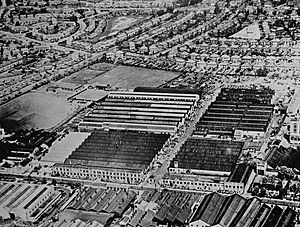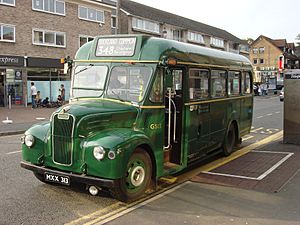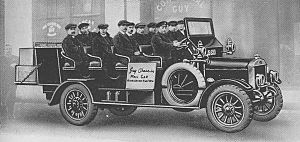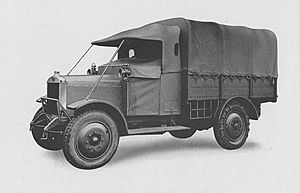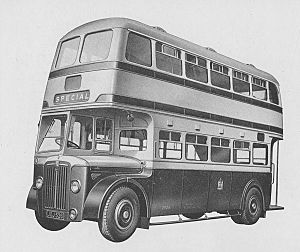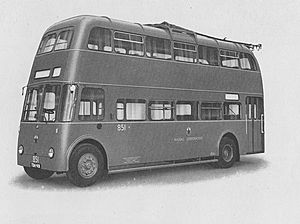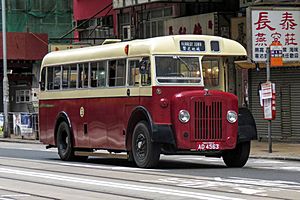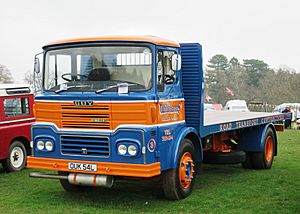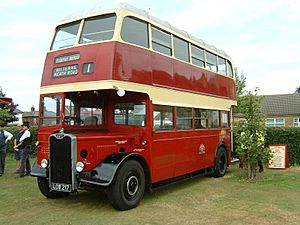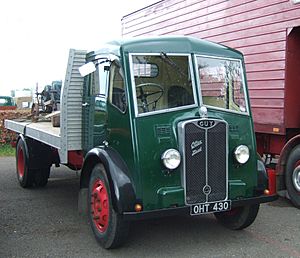Guy Motors facts for kids
Guy Motors was a famous company from Wolverhampton, UK. They made many different vehicles like cars, trucks, buses, and trolleybuses. Sydney S. Guy started the company in 1914. Their main factory was in Fallings Park and operated until 1982. Guy Motors was a big part of Britain's car and vehicle history.
History of Guy Motors
Starting Up and World War I
Sydney S. Guy officially started Guy Motors Limited on May 30, 1914. He had just left his job at another Wolverhampton company, Sunbeam. A new factory was built in Fallings Park, Wolverhampton. By September 1914, they were already building their first vehicle. This was a 30 cwt truck. It had a special light steel frame, which was new for that time. This design helped the truck drive well on rough ground. A 14-seat bus, based on this design, was even used in the Scottish Highlands.
In 1915, Guy Motors began working for the government during World War I. They focused on making things for the war effort. Even so, they released an updated truck in May 1915. A year later, they introduced a new 2-ton truck. This truck used a special engine approved for wartime vehicles. Guy Motors also made airplane engines, truck engines, and gearboxes. They were the biggest maker of depth charge fuses in the country. Because of their hard work, Guy Motors grew a lot during the war. Their factory got bigger, and they became a well-known name in British manufacturing.
In 1919, Guy Motors started making their first car. It was a fancy 4-liter V8 car, the first British V8 engine. They also invested a lot of money to make more trucks. Their goal was to build 40 to 50 trucks each week.
The 1920s: New Designs and Challenges
After the war, Guy Motors was one of the first companies to start making commercial vehicles again. By March 1920, they were expanding their factories and had many orders. However, the years after the war were tough for car companies. Many military vehicles were sold cheaply, which made it hard for new companies to sell their products. Guy Motors also made smaller, more affordable cars in the 1920s.
The main focus for Guy Motors was making truck and bus chassis (the base frame of a vehicle). These could be fitted with different bodies. In 1920, they showed off a bus that could seat 28 people. They also showed a truck that could tip its cargo.
In 1924, Guy Motors started using the slogan 'Feathers in our Cap'. This led to them adding a Native American mascot to their vehicles. That same year, Guy made a very important invention: the first "dropped-frame" chassis for buses. This design made it much easier for passengers to step onto the bus. It became very popular, and Guy received a large order for 170 buses from Rio de Janeiro.
As cities grew, bigger buses were needed. So, Guy developed a 6-wheeled chassis. This led to the first 6-wheeled double-decker buses and trolleybuses in 1926. Guy worked with other companies to design these new trolleybuses. The first one was tested in Wolverhampton in December 1926. Guy's double-decker buses and trolleybuses became very popular. They sold many to the London Public Omnibus Company and exported them all over the world. Sales to places like South Africa, Pakistan, India, and the Netherlands were a big source of income. Their armored vehicles were especially popular for tough terrains.
In 1928, Guy Motors took over another Wolverhampton company called the Star Motor Company. Star made luxury cars but was struggling. Guy hoped to boost their luxury car business. However, Star Motors continued to lose money. The Wall Street Crash in 1929 caused a major economic downturn. This made things even harder for Guy Motors. By 1932, Star Motors had to close down.
Even though Guy Motors had done well for most of the 1920s, they faced an uncertain future. The expensive takeover of Star and the Wall Street Crash caused their share prices to drop a lot.
The 1930s: Surviving the Depression and War Preparations
Guy Motors managed to survive the Great Depression. They received orders from the government for military vehicles. They also benefited from a new law that encouraged lighter vehicles. In 1930, they made a 2-axle version of their BTX trolleybus. In 1933, they launched the Arab bus chassis. This bus was designed for diesel engines and became a very successful model for the next twenty years.
From the mid-1930s, Guy Motors became more involved in preparing for war. They developed and produced military vehicles for Britain. In 1935, Guy showed off their new four-wheel Ant armored car. It was so impressive that the government ordered 150 of them. After this success, Guy focused only on military vehicles. By 1938, all their work was for the government, and they stopped making civilian vehicles.
During this time, Guy designed a new armored car called the Quad Ant. This car was welded together instead of being riveted (joined with special fasteners). Guy developed new welding methods that made armored vehicles safer and cheaper to build. This new method saved the British government a lot of money. It was later used in many other Allied armored vehicles, like the Churchill and Sherman tanks. When World War II began, Guy had built many trolleybus chassis, but their production stopped until 1947.
World War II: Buses for the Nation
Guy armored vehicles were used throughout World War II. They played a big part in the evacuation of Dunkirk and in the North African campaign. Even though other companies took over the production of some armored cars, Guy's factory still helped the war effort. They produced anti-aircraft guns.
During the war, very few new cars and commercial vehicles were made in the UK. Buses were wearing out or being destroyed by bombings. The government asked Guy to produce new buses to keep public services running. Between 1942 and 1945, Guy made over 2,000 double-deck buses. In 1942, Guy launched the Arab I and Arab II utility double-deck buses. These were based on their 1933 design. They were very successful because they were strong, reliable, and cheap to run. Guy's contribution to the war made them a top supplier for the government. This also gave them financial stability after the war.
After the War: New Models and Challenges
After World War II, Guy Motors went back to making vehicles for everyday use. Bus production remained very important. They continued to focus on selling vehicles to other countries, especially South Africa, Pakistan, and the Netherlands. In 1947, Guy received large orders for trolleybuses from Belfast and Wolverhampton. By 1948, Guy bought another company called Sunbeam Commercial Vehicles. After this, all trolleybuses they made were called Sunbeam. Sunbeam trolleybuses sold very well, especially in South Africa.
In 1950, Guy Motors made a deal with Mahindra & Mahindra in India. This allowed them to assemble their vehicles in India and share workers.
In 1953, Guy Motors moved all trolleybus production to their main Fallings Park factory. They kept updating their older models. In 1950, they introduced a new version of the Otter chassis for 30-seater vehicles. London Transport ordered 84 of these. By 1954, Guy buses were used by 150 companies in the UK and in 26 other countries. In 1954, the company also developed the first 30-foot, two-axle double-deck trolleybus chassis. This model, the Sunbeam F4A, could seat 68 passengers.
In 1957, Sydney Guy retired after 43 years with the company he founded. Guy continued to create new and successful vehicle designs. However, a bad business decision hurt the company's money. They decided to lease vehicles in South Africa instead of selling them outright. Many contracts were not paid, which caused big financial problems. This, along with a new double-decker bus called the Wulfrunian, caused more damage. The Wulfrunian, launched in 1958, had many new ideas. But it wasn't tested enough before being sold. This meant it often broke down, which hurt Guy's reputation for reliability.
The Company's Decline and Closure
By 1960, Guy Motors faced huge money problems. The Wulfrunian's failure was a disaster. The South African business was losing them a lot of money each year.
In 1961, Guy Motors had to go into receivership (meaning a company takes control to manage its debts). Sir William Lyons, who ran Jaguar, bought Guy Motors for £800,000. He created a new company, Guy Motors (Europe) Limited. This left the old company with all the debts. Later, the name went back to "Guy Motors Ltd." Jaguar immediately started making changes. They reduced the number of employees and the types of vehicles being made.
Guy Motors continued to do well in the 1960s. They developed the Victory trambus and the Big J series of trucks. The Big J trucks were designed for highways. They used different engines and parts from various suppliers to meet different needs. Each truck's setup was carefully recorded.
However, a series of company mergers put Guy Motors in a difficult spot. In 1966, Jaguar merged with another company to form British Motor Holdings. Then, in 1968, this company merged with Leyland to form the British Leyland Motor Corporation. Leyland stopped making Guy-branded buses in 1972. However, Leyland versions of the Guy Victory bus were still made until 1986. The British car industry was generally struggling, and British Leyland looked for ways to save money.
Guy Motors managed to stay open for a while longer because its Big J trucks were still making a profit. But in 1981, Leyland decided to close the Fallings Park factory. In August 1982, the factory doors shut, and 740 people lost their jobs. On October 5, the factory was emptied, and everything was sold off. The closure of Guy Motors had a very bad effect on the nearby areas. Many workers lived there, and the closure added to the already high unemployment.
Vehicles Made by Guy Motors
Cars
- 20 hp 1919–1923
- 16.9 hp 1922–1924
- 13/36 1924–1925
Buses and Trolleybuses
- B series (including BT 2-axle and BTX 3-axle trolleybuses)
- C series
- Arab Mk I/II/III/IV/V
- Arab UF/LUF
- Wolf
- Vixen (see information on 1953 London Transport Guy Special)
- Warrior Trambus
- Wulfrunian
- Victory
- Sunbeam/Karrier S7/S7A – 3-axle 30 ft and 33 ft double-deck trolleybuses
- Sunbeam/Karrier F4/ F4A – 2-axle 26 ft, 27 ft and 30 ft double-deck trolleybuses
- Sunbeam MF2B – trolleybus chassis for export, some used in Bournemouth and Hull
Trucks and Other Vehicles
- Armoured Car
- Lizard – Armoured Command Vehicle
- FBAX – Truck 3/5 Ton 6 x 4, General Service, Searchlight, Machinery, Wireless, Breakdown Gantry, Derrick.
- Ant – Truck 15cwt 4 x 2, General Service (G.S.) & Wireless (house type)
- Quad-Ant – Truck 4 x 4 Field Artillery Tractor (F.A.T.) & 15cwt G.S.
- Wolf
- Vixen
- Warrior (1956)
- Invincible
- Big J (1964–78)
- Otter
See also
- List of car manufacturers of the United Kingdom


